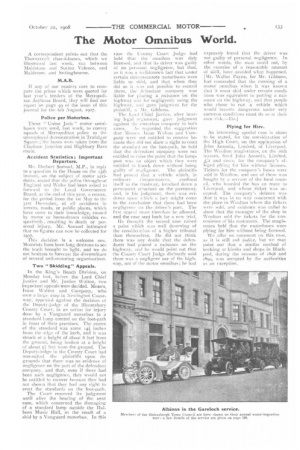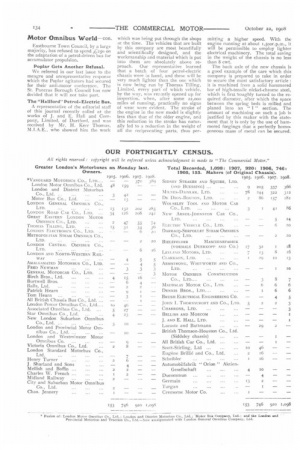The Motor Omnibus World.
Page 7

Page 8

If you've noticed an error in this article please click here to report it so we can fix it.
A correspondent points out that the Thornycroft char-à-bancs, which we illustrated last week, ran between Maidstone and Sutton Valence, and Maidstone and Sittingbourne.
M.A.B.
If any of our readers care to compare the prices which were quoted for last year's tenders of the Metropolitan Asylums Board, they will find our report on page 49 of the issue of this journal for the Sth August, 1907.
Police per Motorbus.
Three " Union Jack " motor omnibuses were used, last week, to convey squads of Metropolitan police to the unemployed demonstration in Trafalgar Square; the buses were taken from the Clapham JIIliCt ion and Highbory Barn route.
Accident Statistics ; Important Departure.
Mr. Herbert Samuel, M.P., in repl) to a question in the House on the 15th instant, on the subject of motor accidents, stated that the police throughcut England and Wales had been asked to forward to the Local Government Board, at the end of this ear, a return, for the period from the 1st May to the 31st December, of all accidents in streets, roads, or public places, which have come to their knowledge, caused by motor or horse-drawn vehicles respectively, resulting in death or personal injury. Mr. Samuel intimated that no figures can now be collected for 1907.
This decision is a welcome one, Motorists have been long desirous to see the truth brought to light, and we do not hesitate to forecast the discomfiture of several anti-motolring organisations.
Two "Skidding" Appeals.
In the King's Bench Division, on Monday last, before the Lord Chief Justice and Mr. justice Walton, two important appeals were decided. Messrs. Isaac Walton and Company, who own a large shop in Newington Causeway, appealed against the decision of the Deputy-judge of the Bloomsbury County Court, in an action for injury done by a Vanguard motorbus to a standard lamp erected on Lime foot-path in front of their premises. The centre of the standard was some 14 inches front the edge of the kerb, and it was struck at a height of about 8 feet front the ground, being broken at a height of about 5..1,feet howl the ground. The Deputy-italge in the County Court had non-suited the plaintiffs upon the grounds that there was no evidence of negligence on the part of the defendant company, and that, even if there had been such negjigeuce, they would not be entitled to recover because they had not shown that they had any right to erect the standards on the foot-path.
The Court reserved its judgment until after the hearing of the next case, which concerned the damaging of a standard lamp outside the Holborn Music Hall, as the result of a skid by a Vanguard motorbus. In this
case the County Court Judge had held that the omnibus was duly licensed, and that its driver was guilty of no persoual negligence, but that, as it was a well-known fact that under certain circimistances motorbuses were liable to skid, and that when they did so it was not possible to control them, the d(!fendant company was liable for placing a nuisance on the highway anti for negligently using the 'highway, and gave judgment for the plaintiff, a Mr. Gibbons.
The Lord Chief justice, after hearing legal argument, gave judgment against the motorbus company in both
cases. regarded the suggestion that Messrs. Isaac Walton and Company were not entitled to recover because they did not show a right to erect the s-tandard on the foot-path, he held that the defendant company were not entitled to raise the point that the lamppost was aim object which they were entitled to knock down without being guilty of neOigence. The plaintiffs had proved that a vehicle which, in
ordinary circumstances, confined itself to the readway, knocked down a permanent structure on the pavement, and, in his judgment, there was evidence tiiten which i jury might come to the conclusion that there had been negligence on the driver's part. The first apprei must therefore be allowed, and the case sent back for a new trial.
He thought the second case raised a point which was well deserving of the consideration of a higher tribunal than themselves. He did not think there was any doubt that the defendants had placed a .nuisance on the highway, and he would point out that the County Court Judge distinctiv said there was a negligent use of the highway, not of the motor omnibus ; he had expressly found that the driver was not guilty of personal negligence. In other words, the man could not, by the exercise of a reasonable amount of skill, have avoided what happened. [Mr. Walter Payne, for Mr. Gibbons, had contended that the running of a motor omnibus when it was known that it must skid under certain conditions was equivalent to putting a nuisance on the highway, and that people who chose to run a vehicle which would become dangerous under very common conditions must do so at their own risk.—EL.
Plying for Hire.
An interesting special case is about to be stated, for the consideration of the High Court, on the application of John Ansonia, Limited, of Liverpool. The Minh= magistrates, en the 16th instant, lined John Ansonia, Limited, ,4..2 and cosi s, for the company's alleged plying for hire without licenses. Tickets for the cc)mnpany 's buses were sold in Wooiton, and one of these was bought bv a sta vont of the local council, who hoarded the bus en route to Liverpool, and whose ticket was accepted. The company's defence was that it was in no way concerned with the place in Woolton whore the tickets were sold, and evidence was called to show that the manager of the shop in Woolton sold the tickets for the convenience of his customers. The magistrates held that the inotorbuses were plying for hire without being licensed.
We offer no comment on this case, as it is still sub iudice, but W11 may point out that a similar method of booking at kiosks and shops in Blackpool, during the seasons of 180 and 1899, was accepted by the authorities as an exception.
Eastbourne Town Council, by a large majority, has refused to spend £250 on the adaptation of a petrol-driven bus for accumulator propulsion.
Poplar Gets Another Refusal.
We referred in our last issue to the meagre and unrepresentative response which the Poplar agitators had secured for their anti-motor conference. The St. Pancras Borough Council has now decided that it will not take part.
The "Hanford" Petrol-Electric Bus.
A representative of the editorial staff of this journal recently called at the works of J. and E. Hall and Company, Limited, of Dartford, and was received by Mr. H. Kerr Thomas, M.I.A.E., who showed him the work which was being put through the shops at the time. The vehicles that are built by this company are most beautifully and scientifically designed, and the workmanship and material which is put into them are absolutely above reproach. Our representative learned that a batch of four petrol-electric chassis were in hand, and these will be very much lighter than the one which is now being run by Thomas Tilling, Limited, every part of which vehicle, by the way, was rec,mtly opened up for inspection, when, after some 22,000 miles of running, practically no signs of wear were evident. The stroke of the engine in the new model is slightly less than that of the older engine, and this reduction in the stroke has naturally led to a reduction in the weight of all the reciprocating parts, thus per mitting a higher speed. With the engine running at about 1,500r.p.m., it will be permissible to employ lighter electrical machinery. The total saving in the weight of the chassis is no less than 8 cwt.
The back axle of the new chassis is a good example of the care which this company is prepared to take in order to secure the most satisfactory article : it is machined from a solid hammered bar of high-tensile nickel-chrome steel, which is first roughly turned to the required diameter, after which the space between the spring beds is milled and planed into an " 1" section. The amount of machining on such a job is justified by this maker with the statement that it is only by the use of hammered forg-ings that a perfectly homogeneous mass of metal ran be secured.




















